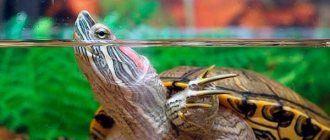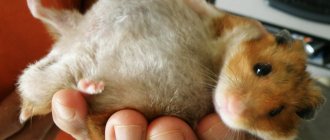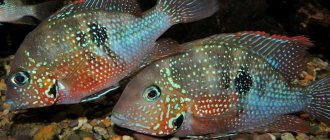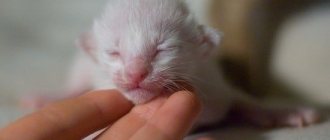Reproduction of hamsters
Since you are already here, then, most likely, you have already read our ABC’s on breeding hamsters, reduced to one article. Therefore, today we will talk about such a breed as Djungarian hamsters, whose maintenance features we have also already written about.
Now it's time to talk about reproduction. Did you know that Djungarian hamsters reproduce very easily and quickly in captivity? Therefore, if you become the owner of a pair of such small rodents, then you should prepare for the fact that your hamsters will soon have abundant offspring, and they will appear with enviable frequency, which is what we’ll talk about today.
Sexual characteristics of domestic rodents
For the mating process to be successful and effective, you will need a male and a female. There were incidents when the owners tried to bring two girls or boys together. Naturally, such pimping did not bear fruit. Therefore, first, determine the sex of the individuals selected for reproduction.
In the case of adult animals, this is not difficult to do, because the male most often has healthy testicles! But if you buy young animals, hoping to further breed Djungarian, Syrian (or any other breeds) of hamsters at home, carefully examine their tummy.
- Signs of a female: the body is slightly larger than that of boys; The genital opening is located under the tail next to the anus.
- Signs of a male: the body is slightly smaller, the distance from the anus to the genitals is significant; starting from 2-3 months of age, eggs begin to appear clearly.
Although sexual dimorphism is expressed in the size of animals, you should not rely on this feature. After all, rodents from different litters can live in a pet store; they have different ages and different degrees of fatness. Therefore, estimate the distance between the holes.
The photo shows a female:
Is it possible to castrate a hamster
Rodents are solitary by nature. Regular estrus does not cause much trouble for either the animal or the owner. Castration of a hamster is carried out extremely rarely, since miniature creatures do not tolerate anesthesia well.
If from the owner's point of view this operation is necessary, consult a specialist.
There is no chemical sterilization for hamsters. Rodents are castrated in emergency cases, in the presence of serious diseases. Sexual heat does not harm the hamster's body, so mating is not necessary.
Reproduction statistics
Every owner should understand that breeding hamsters at home is a responsible process. It cannot be carried out at random, and the offspring that appears 3 weeks after birth will have to be accommodated. Many owners are simply shocked by the fertility of these small rodents!
Here are interesting facts about the mating of Djungarian hamsters, expressed in numbers:
- 3 weeks – age of puberty of dzhungarikas;
- 5 minutes is the average duration of sexual intercourse;
- 21 days is the optimal period for bearing offspring;
- A female can give birth to 18 babies in one litter (but more often 5-9);
- The girl rests for 7 days after giving birth, and then she is ready to become pregnant again.
As you can see, khomas begin to ripen very early. But if early mating is not at all harmful for the male, then an incompletely formed hamster may die during early pregnancy. Therefore, the optimal age for breeding Djungarian hamsters is 3 months. The maturation and gestation periods for Roborovsky hamsters are the same, but the offspring are slightly smaller: 3-9 hamsters.
Syrian hamsters also reproduce interestingly. The female shows interest in mating only during the period of estrus, and the male, like a true gentleman, is constantly interested in girls. The Syrian hamster bears its offspring for an average of 18 days. Sometimes this period lasts up to 3 weeks. Syrian hamsters are born in numbers from 5 to 15 pieces.
Puberty of Djungarian hamsters
Djungarian hamsters are ready to breed at one month of age. At this time, the female begins her first heat, and she can already become pregnant. However, early childbirth can be harmful to her health. Firstly, the hamster’s body is not yet strong and it is possible that complications will arise during pregnancy or childbirth.
A month-old female is not ready for reproduction for another reason - she has not yet developed maternal instinct. Because of this, the rodent may eat its newborn babies or refuse to feed them.
It is recommended to start breeding Djungarian hamsters when they are at least 3-5 months old. But you should not postpone the first mating for a long time - with age, the female loses her ability to reproduce.
The suitable age for breeding dzhungarikas is 4-10 months.
As the year approaches, the female's health deteriorates. It is becoming increasingly difficult for her to become pregnant, carry her to term and give birth to healthy babies.
Choosing a partner
You already know at what age jungariks and other animals will reproduce best. If you have one Homa living with you, it’s time to choose a mate for him.
- Firstly, the partner must be the same breed as your pet. That is, a Djungarian hamster must mate with a Djungarian hamster, and a girl Syrian hamster must mate with a Syrian, etc. Interbreeding of hamsters at home rarely brings results.
- Secondly, the partner must be of the opposite sex. And you already know how to determine the gender of rodents.
- Thirdly, both animals must be healthy, free from external pathologies and infectious diseases, so as not to give them to future babies.
- Fourth, choose a partner who is similar in appearance to the female. This will increase the chances of producing a pure line of hamsters (line breeding).
- Fifth, try to avoid inbreeding, when hamsters that are siblings, parents and children mate. Such crossing will increase the chance of pathologies and deformities in the offspring.
The couple must not only match in appearance, the male and female must like each other. Choose a time when both animals are active, fed and happy. This will increase the chance of having intercourse “on the first date.”
How do Syrian hamsters reproduce at home?
Caring for a hamster is very simple, even children can handle it. You just need to explain all the nuances of feeding and care. Breeding Syrian hamsters at home requires responsibility and care.
Room equipment
It is necessary to choose a place to place the cage so that it is spacious, away from noise and dust. The cage should be located away from direct sunlight. It is necessary to frequently ventilate the room, but at the same time strictly avoid drafts.
In order for the reproduction of Syrian hamsters to be successful, it is necessary to prepare several cages:
A large and spacious cage where the female will be with her offspring after giving birth. In this cage you need to equip a queen cell where the birth will take place. You need to add a small layer of sawdust to the bottom. It is extremely necessary to arrange an active area so that there is a place where kids can frolic. The spinning wheel, rungs and ladders are perfect for outdoor activities. Cage or box for mating. Here you can get by with a small box; it needs to be free of distracting objects (wheels, ladders). You can add sawdust or special filler to the bottom.
It is important to place the box where it is out of reach of children, dogs and other pets. An additional cage where, if necessary, the Syrian hamster can be placed in case of any aggression from other animals.
Purchasing rodents
A lot depends on the choice of partner for mating. Breeding Syrian hamsters is a responsible matter and must be taken seriously so as not to endanger the lives of the entire Syrian hamster family. A pair of the opposite sex should be selected the same as your pet. Hamsters should not be closely related to each other, otherwise brother and sister may produce weak offspring with signs of pathology and physical inferiority.
It is important to be able to distinguish a male Syrian hamster from a female. Only healthy rodents without diseases or transmittable infections are allowed for mating
The coat of the purchased animal should be shiny, thick and without bald spots. The eyes and nose should be clean and free of discharge
It is also worth paying attention to the emotional state of the hamster. In a normal state, the animal behaves actively, showing interest in everything new, without being afraid of an outstretched hand
However, too energetic behavior of an animal should alert you, as well as too apathetic behavior.
To give your pet time to get used to a new territory, you need to buy a Syrian hamster at a young age. After purchasing a partner, hamsters should be kept separately from each other so as not to suffer as a result of aggression from the partner. Mostly females show aggression, not allowing the male to approach them. They are favorable to their partner only during estrus, which lasts 3-4 days.
Syrian hamster: reproduction
Syrian hamsters reach sexual maturity when they are between 1 and 2.5 months old. But at this age it is not recommended to mate, since the delayed physical development of the female can negatively affect the bearing and feeding of offspring. The female may not have enough milk for large offspring. Therefore, it is worth involving a female in breeding for the first time no earlier than when she reaches three months of age. If your first birth occurs after she is six months old, there is a risk of complications during pregnancy and childbirth. The male is capable of healthy fertilization at the age of 3 months to one and a half years.
Before mating begins, you need to find out when the female is in heat; it is on such days that you can place a male with her. The main signs of estrus in a female Syrian hamster are similar to other animals. She becomes more active than usual and can stand up, arching her back and spreading her paws. Under the tail you can notice a mucous discharge with a pungent odor. Syrian hamsters are nocturnal animals; they are active mainly at night, including mating. Estrus can begin in the evening and last until the morning. It is necessary not to miss this moment and place a male with her. The next chance will be only in 4-5 days
If you are sure that the right moment has come right now, you need to carefully bring the male to the female. After sniffing each other, the girl can stand up, thereby showing her consent
Now you need to leave the couple in a quiet, calm place for the duration of mating and not disturb them. Half an hour will be enough for conception; during this time you need to be careful and, if the female becomes aggressive, immediately isolate the male from her. There have been cases when a female bit her partner to death.
Calculating the time of mating
The Djungarian hamster, Syrian and representatives of other breeds are crepuscular animals, which is why they prefer to breed at night. But not only the daily rhythms of these animals are important, but also the individual cycles of the female. While the furry Don Juan is ready to mate any day, the female shows sexual activity only during estrus.
Breeding hamsters at home depends on how correctly you calculate the time to introduce the male. But this is not easy to do, you have to seize the moment, because the female’s readiness lasts only 4-12 hours, and after that there is a break for 3-5 days. Typically, estrus begins in the evening, so you only have one night to mate your hamsters.
Here are the signs by which you can determine when a female is in heat:
- the pet becomes too active;
- small mucous discharge appears under the tail;
- often the mucus has a peculiar smell that attracts males;
- the hamster tries to bend her back, spreading her paws, while her butt and tail lift up a little;
- The female reacts loyally to the approach of the male.
Syrian hamsters very clearly display all of the listed signs, but girls of the Djungarian breed are more modest, so it is much more difficult to determine when they are in heat.
Complications during childbirth
Complications can often occur during pregnancy, childbirth and afterward.
Toxicosis
Females experience toxicosis in the last days of pregnancy. There is no cure for this condition, but the consequences can be serious: the female and her cubs die during or after childbirth.
Death of fetuses in the uterus
If a mother gives birth to still babies, it means they died in the womb. This occurs due to poor nutrition, infections, age and physiological characteristics. If after this you do not undergo surgery to remove the uterus, the hamster will subsequently die from blood poisoning.
Pathology of childbirth
If labor is protracted, you should immediately consult a doctor. This situation occurs due to the age of females, whose pelvic bones become inelastic over time, due to the large size of the fetus.
Endometritis
The disease causes inflammation of the uterus, characterized by bleeding that lasts more than three days.
Choosing a place to mate
For the breeding of hamsters to produce results, the couple in love must be left alone. The owners will only disturb the animals and distract them from their work. Many are worried that the boy and girl will not understand why they were put together. But this is stupid! In the wild, animals somehow find each other on their own and calmly reproduce. So why shouldn’t small pets cope on their own, because no one has canceled their instincts!
First, you need to find a cozy corner in your home where there will be no drafts, noise and threats in the form of curious pets. The marriage bed is placed there. It is best to keep hamsters not in a cage, where there are a lot of distractions (a wheel, other toys, food), but in a separate box made of thick cardboard or plastic. But it should be spacious enough, don’t forget to add filler. If you have a spare cage, that will work too.
So, you need to place two hamsters, a boy and a girl, in a love nest. At first, you can watch your pets and see how they get to know each other. If the hamster reacted favorably to the appearance of the gentleman, then move the box with the pets to where no one will disturb them. This is how hamsters of all breeds are reproduced.
The photo shows how the Dzungarians look closely at each other.
Care of offspring
After giving birth, the mother needs rest - at least for a week. After this time, she will again be ready to mate and conceive.
A nursing mother will need good nutrition and a constant supply of clean water . It is advisable to purchase special food at a pet store so that the hamster’s breast milk is as rich as possible in the vitamins and minerals necessary for the normal development of healthy offspring.
The cage where the babies are located must be spacious - at least 50 by 30 cm. The temperature in the room where the babies live must be maintained at 21-25°C . The house with newborns should be in a shaded, quiet place.
Thus, the owner must create all favorable conditions for the new mother, but not interfere in the process of caring for the babies.
If the mother nevertheless abandoned the cubs, then you need to try to feed them yourself. For this you will need baby formula. However, the chances of survival for abandoned babies are low.
Sexual intercourse in hamsters
It is not customary for domestic rodents to have long foreplay; usually, after a short introduction and sniffing, they immediately get down to business. And why wait, because their life is so short!
So, you left your pets alone in a secluded place. If the female is completely ready for mating, then the male piles on top of her and hugs his girlfriend around the waist with his tiny paws. The submissive bride does not object, she leads the seed quietly and meekly, but Don Juan is very active! The mating process for representatives of the Dzungarian breed and other dwarfs lasts no more than 5 minutes; Syrians usually inseminate a hamster longer.
If a couple consists of a very calm girl and a small active boy, they may have intercourse several times throughout the night. In such cases, in the morning the male falls exhausted. Such a vigorous sex life can undermine the health of a hamster and even temporarily drive it into stupor.
In the photo, Roborovsky’s gentleman hugged his chosen one:
Sometimes problems arise during or before sexual intercourse. You need to know when it is better to place a couple in different cages.
At what age do jungarians begin to mate?
Puberty in hairy hamsters occurs at 1-2 months. It is better to pair with a younger male and an older female. Ideally, the boy will be 3 months old, and the girl – 4. It is at this age that the female will be ready to take care of the offspring, and childbirth will become safe for her body.
If you still do not have information on how to determine the sex of hamsters, then you can do this already a month after birth. To do this, measure the distance between the animal's anus and genitals while lying on its back. If it is 0.5-1 cm, and in the center of the abdomen there is a small bulge - the male gland, then this is a male. Already at 2-3 months you will be able to see the testicles. If the distance is less than 0.5 cm, and there are 2 rows of nipples on the stomach, then it is a female. The female is also usually slightly larger than the male.
Important! A month after birth, females and males must be placed in different cages.
When to place rodents?
The sudden appearance of a cat next to hamsters preparing to mate, or an unexpected sharp sound can drive the animals into severe stress. They are capable of not only abandoning the task assigned to them, but also starting to fight. The mood of those getting married changes very quickly, regardless of their type. Fights can be so serious that one of the animals is severely injured or killed. Usually the strongest blows go to the male.
The following describes situations in which it is better to postpone mating of hamsters until better times:
- The girl initially did not like the male. In this case, you need to introduce the hamsters gradually or choose another boyfriend for your pet.
- The girl is not ready. If the hamster is not currently in heat, she will react especially aggressively to a furry man who appears nearby. Be sure that the lady will use not only her claws, but also her teeth. In such a situation, it is necessary to urgently remove the Djungarian boy and wait for the moment of estrus.
- Sudden fear. Due to stress, both hamsters can simply go wild and start fighting. In this case, their separation is necessary.
- The process is over. Not all hamsters, unlike individuals of the opposite sex, are ready to copulate all night. When the female decides that she has had enough, she will become restless and begin to show bouts of aggression. In this case, the partner should also be removed.
Sometimes hamsters can be left alone for half an hour to do their simple task. But you can leave only if the pets have established contact and they treat each other favorably. Still, it’s better to be nearby in case of a hamster force majeure. Usually the gentleman manages to inseminate the female within half an hour, then he can be separated.
By the way, some rodents have no complexes at all: they manage to mate in the presence of their owners, almost sitting in their arms!
In the photo copulating Syrians:
Why you shouldn't breed hamsters
Before you start breeding hamsters, you need to decide for yourself whether you are ready to devote enough time to caring for rodents. You need to think about all the nuances before purchasing the first pair of animals, because then it will be difficult to understand where to put the offspring.
Very often it is not possible to sell pet rodents profitably, and the owners simply take them to the market or to pet stores. In the latter case, one can only hope that the animals will not become food for the snakes. That is why hamster breeders are, first of all, people for whom this business is a kind of hobby and only then a business. Below are the main problems that breeders face in the first months of breeding hamsters.
We recommend reading which is better to get - a rat, a hamster or a guinea pig.
Affects the health of the female
Quite often there are situations when a pregnant female weighs less than 120 g. In this case, it is very difficult for her to give birth, and she may even die during childbirth. This happens if the partner with whom mating took place was much larger. It is also impossible to avoid pathologies of the birth process with rodents that are older than 14 months. Although hamsters live up to 3-4 years, the rest of their life after a year is considered old age for them.
In addition, it should be remembered that during bearing and feeding their offspring, females lose up to 30% of their body weight. If the animal was initially small, there is an increased likelihood that the body will be completely exhausted and the animal will die. Even if such a female manages to survive, she will no longer be able to reproduce.
During pregnancy, the female cannot act as a pet
It is also worth understanding that, being “in pregnancy,” the female is not a pet with whom you can constantly play. The last week before giving birth is a period when the hamster needs complete peace and quiet. Also, she should not be picked up in the next three weeks after birth. Otherwise, she may not recover or eat the offspring.
It is worth understanding that if you get a hamster for a child, then it will be very stressful for him to see how a hamster kills her children. This should definitely be taken into account by parents who decide to have a furry pet in order to teach their child to be independent.
It is useful to know the rules for taming a Syrian hamster.
Even if the young animals are already covered with fur, and you decide to pick up the rodents, you should not give them to children first. First, you need to accustom the rodents to the hands of adults, since small hamsters very often behave aggressively, bite and try to slip out of the hands. Adults will have to make enough efforts to make the young animals socially adapted.
Determining pregnancy
Not everyone knows how to determine whether a pet is pregnant or not. The fact of conception is usually established 10 days after mating, since in the early stages there are practically no external signs.
Here are the symptoms of pregnancy in a hamster:
- the tummy increases in size (sometimes this is not noticeable due to the luxurious fur);
- nipples swell;
- the hamster’s behavior becomes abnormal: too aggressive or atypically affectionate;
- appetite increases;
- the desire to stockpile increases;
- the female approaches the running wheel less often.
All these signs indicate that there will soon be a new addition to the hamster family.
How does pregnancy proceed in a female dzhungarika
Pregnancy in a female Djungarian hamster lasts from 17 to 21 days. If labor does not occur on both the 22nd and 23rd days, the help of a veterinarian may be required.
During pregnancy, the female should not be nervous or worried, and if the male irritates her, it is better to move him out of the cage to another place. Feed the expectant mother fresh vegetables and fruits, give her egg whites, you can give her a small piece of boiled chicken meat, dairy products, and be sure to provide her with a mineral chalk stone.
Also provide the female with building material for the nest - cage filler is suitable as such material.
A few days before the expected date of birth, remove the cage and hide the running wheel - the expectant mother will certainly not need it in the coming days.
How does childbirth occur?
Usually the female gives birth in a squatting position or on her side. Depending on the number of cubs, birth lasts from 1 to 2 hours, that is, quite quickly. The interval between newborns coming out is about 15 minutes. The hamster chews the membranes, uses its teeth to cut off the umbilical cord. She eats the membranes and placenta.
If you took good care of your pet and fed it properly during pregnancy, then childbirth will be easy. But there are also some complications in which the hamster can die or give birth to non-viable offspring. In such a situation, only a doctor can help, and not always.
Newborn animals are bald and helpless. Because of this, their mother has to take care of them. She builds a comfortable nest for them and begins to feed them milk.
Pregnancy and birth of hamsters
A hamster's pregnancy lasts on average only 14-19 days, while in Djungarian hamsters the pregnancy can last up to 30 days. On the tenth day, visible signs of pregnancy appear, and it is from this moment that the expectant mother’s weight begins to rapidly increase. If the female's weight decreases during pregnancy, this may indicate illness or death of the embryos inside the womb.
Approximate duration of pregnancy for:
- Syrian hamsters and Roborovsky hamsters – 16-17 days;
- Campbell's hamsters and Siberian hamsters - 19-20 days.
Expectant mothers move very carefully, trying not to make sudden movements. Do not disturb a pregnant female unless absolutely necessary! Include more protein in her diet (this could be egg whites, cheese, cottage cheese, baby meat food, etc.).
3 days before giving birth, the female’s thirst increases. During this time, the water should be changed at least 3-4 times a day.
Labor usually begins at night. Set up a house or nest in the cage in advance (you can use a cardboard box). The hamster arranges everything inside the nest herself, just don’t forget to provide her with soft paper, napkins and hay. The cage where the hamster will give birth should be in a quiet and peaceful place.
Usually the pet copes well with the birthing process on its own, and in the morning the owners discover a new baby. Hamsters are born in a shell, the mother gnaws it in the area of the baby's head, and the baby takes its first breath. Each hamster litter can have anywhere from four to eighteen babies. Babies are born completely helpless, deaf, blind, tiny, their skin is thin and red. The only thing that babies have perfectly developed is the ability to distinguish smells.
Experienced breeders and veterinarians can help with the birthing process when a female is giving birth for the first time or when a large number of babies are being born.
But there are times when during the birth process the help of a veterinarian is necessary, namely:
- if, with obvious contractions and pushing after 15 minutes, there are no results
- After the birth of the first baby, after 30 minutes, the remaining babies are not born.
Within 30 min. After giving birth, a healthy mother will definitely eat before starting to feed her babies. Refusal to eat may mean the occurrence of any postpartum complications. The vaginal membrane closes in the first two days after birth, and at this time you may notice slight bleeding from the birth canal.
The first time a hamster usually gives birth to 4-5 babies, subsequent litters can include many more babies.
A few words about the kids
Newborn hamsters develop quickly and learn about the world. But for the first week they do not leave the nest at all, feeding on the milk of their furry mother. Breastfeeding lasts from birth to 3 weeks. During this period, it is better not to touch the animals, because a hamster may lose milk due to stress, and an angry mother in labor may abandon her babies altogether. In this case, you will have to feed the hamster offspring yourself, and many of the babies will die.
To prevent this problem from arising, provide the family with peace for the first 2 weeks. The bedding is also not changed during this period, but only a little food is added. At one week of age, babies begin to crawl blindly around the cage. And already at the age of 2 weeks they open their eyes. Around this period, complementary foods consisting of low-fat yogurt and peeled seeds should be introduced.
At 3 weeks, babies are already covered with thick fluff and can eat on their own. This means that it is time to remove them from their mother. Watch the babies for another week, and already at the age of 1 month you can give the miniature animals to new owners.
If you decide to keep the kids for further breeding, then at the same age determine their gender and place the boys and girls in different cages. This precaution will not allow the reproduction of small rodents to take its course.
There are many nuances in the reproduction of hamsters. You need to remember that mating of animals must be timely, voluntary and safe for both participants. At the slightest sign of aggression, separate the animals from each other! An important aspect of reproduction is the gestation period. In this position, the pet needs absolute rest and increased nutrition.
Problems when breeding hamsters
Cubs can be born dead, die during childbirth, or become victims of a negligent mother.
Dead cubs can be born to a healthy female for the following reasons: infection, disease, poor nutrition, poor diet during pregnancy, lack of essential vitamins and microelements in food.
Often a pregnancy, especially the first one, ends with the hamster eating the babies. There are quite a few reasons for this:
- improper diet during pregnancy, in particular, insufficient amount of animal protein in the diet;
- the failed mother is too young;
- stress or fear after childbirth;
- in the cage where the hamster gave birth, there is a male who poses a threat to her babies, and therefore she directs aggression either at the male, and if this fails, then at the babies;
- regulation of the number of offspring (a female hamster has 5 or 6 pairs of nipples, and so many babies can be born that she will not be able to feed them all);
- if the baby was born weak, sick or with a birth defect;
- if a person picks up a small hamster in his arms in the first week after giving birth, which causes the baby to develop a foreign smell.
There is also a situation when the cubs die due to the excessive care of the mother, when, worrying about the safety of the offspring, she constantly moves the cubs in search of a safer place.
Babies can be born completely healthy, and yet die in the first week of life. This may happen due to the fact that the female is not able to fully feed her babies (insufficient amount of milk or its complete absence).
Poor nutrition, lack of drinking water, heat in the room where the cage with a pregnant female is located and stress can cause the death of a hamster just before giving birth or at the very beginning of feeding newborns. This condition is often called hamster pregnancy toxicosis. Signs of pregnancy toxicosis in females: lack or decreased appetite, dull and tousled fur, muscle spasms, and drooling.
Attempts to cure this problem are unsuccessful in most cases. Prevention is important here - providing the most comfortable conditions for a pregnant hamster (constant humidity and air temperature, absence of drafts, peace and quiet, as well as a properly formulated diet and access to fresh, clean water).
For some people, breeding hamsters is a business. Others conjure genetics, putting their soul into the nursery. Still others had no intention of breeding hamsters at all, but got offspring by accident.
Knowing at what age hamsters begin to mate, the breeder must have time to place the young animals in different cages according to gender.
The optimal period for the first mating is from 4 to 6 months. Second mating – 8-10 months (for the female). The animal is allowed to recover after birth for at least 2 months, and preferably 3-4 months.
Males retain reproductive abilities throughout their lives, and they can be bred as early as 5 weeks. But frequent mating is also undesirable - it exhausts the producer, and many females do not become pregnant after mating.
Contraception methods
The high fertility of small rodents can cause a lot of trouble for their owners.
High fertility causes a lot of problems for the owners of cute animals. The only way to protect against unwanted offspring is to seat girls and boys in separate cages.
There are no birth control pills available, and veterinarians do not sterilize hamsters. They can do this only for medical reasons, for example, a tumor is discovered in a hamster.
The only method of contraception is keeping pets apart.
Keeping hamsters of different sexes before mating: together or separately
Before mating, hamsters must be kept separately , otherwise they may breed too often. This situation can cause weakening of the female’s body and the birth of weak offspring. Therefore, mating of hamsters for reproduction should be carried out as planned.
When forming breeding pairs, the following should be considered:
- a large female cannot be mated with a small male, she can behave aggressively and harm him;
- a small female is not mated with a large male, since the offspring can take on the size of the father, and she will have problems giving birth to such large babies;
- you should not bring relatives together, as they may give birth to unhealthy offspring burdened with genetic abnormalities;
- you should not breed aggressive individuals - such behavior can be genetically determined and inherited;
- fatty individuals should not be combined. First, you need to review their diet and switch them to lighter foods containing less fat and carbohydrates and more vitamins in order for them to lose excess weight. Hamsters that are too fat are often infertile, and your efforts to breed them will be in vain.
Important! Many people keep hamsters in pairs, and this is wrong. These rodents are solitary by nature and do not respond very well to proximity. Same-sex individuals may begin to fight for territory, which may lead to the death of one of them.
When a male and female hamster live together in a cage, mating occurs during the female's estrus period. In this case, the hamster may experience lactation and pregnancy at the same time, which greatly weakens her health.
How to determine heat
Catching the moment when female hamsters begin to hunt is important for successful mating and further reproduction. If the hamster is not in heat, mating can lead to a fight and injury to both individuals. Hamsters come into heat every fifth day and last only a day. This period in the female is accompanied by mucous discharge.
Some obvious signs will help to determine for sure a change in the hamster’s body:
- presence of musky odor;
- appetite decreases sharply;
- restless behavior;
- when stroking the back, the female begins to bend and raise her tail;
- calm reaction to the male.
Under unfavorable conditions at home in females of mature and young age, estrus may disappear. This often happens when your pet is frequently hypothermic.











